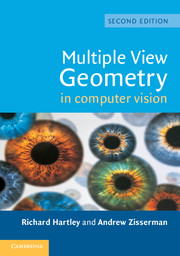Book contents
- Frontmatter
- Contents
- Foreword
- Preface
- 1 Introduction – a Tour of Multiple View Geometry
- PART 0 The Background: Projective Geometry, Transformations and Estimation
- PART I Camera Geometry and Single View Geometry
- 6 Camera Models
- 7 Computation of the Camera Matrix P
- 8 More Single View Geometry
- PART II Two-View Geometry
- PART III Three-View Geometry
- PART IV N-View Geometry
- PART V Appendices
- Bibliography
- Index
6 - Camera Models
Published online by Cambridge University Press: 25 January 2011
- Frontmatter
- Contents
- Foreword
- Preface
- 1 Introduction – a Tour of Multiple View Geometry
- PART 0 The Background: Projective Geometry, Transformations and Estimation
- PART I Camera Geometry and Single View Geometry
- 6 Camera Models
- 7 Computation of the Camera Matrix P
- 8 More Single View Geometry
- PART II Two-View Geometry
- PART III Three-View Geometry
- PART IV N-View Geometry
- PART V Appendices
- Bibliography
- Index
Summary
A camera is a mapping between the 3D world (object space) and a 2D image. The principal camera of interest in this book is central projection. This chapter develops a number of camera models which are matrices with particular properties that represent the camera mapping.
It will be seen that all cameras modelling central projection are specializations of the general projective camera. The anatomy of this most general camera model is examined using the tools of projective geometry. It will be seen that geometric entities of the camera, such as the projection centre and image plane, can be computed quite simply from its matrix representation. Specializations of the general projective camera inherit its properties, for example their geometry is computed using the same algebraic expressions.
The specialized models fall into two major classes – those that model cameras with a finite centre, and those that model cameras with centre “at infinity”. Of the cameras at infinity the affine camera is of particular importance because it is the natural generalization of parallel projection.
This chapter is principally concerned with the projection of points. The action of a camera on other geometric entities, such as lines, is deferred until chapter 8.
Finite cameras
In this section we start with the most specialized and simplest camera model, which is the basic pinhole camera, and then progressively generalize this model through a series of gradations.
Information
- Type
- Chapter
- Information
- Multiple View Geometry in Computer Vision , pp. 153 - 177Publisher: Cambridge University PressPrint publication year: 2004
Accessibility standard: Unknown
Why this information is here
This section outlines the accessibility features of this content - including support for screen readers, full keyboard navigation and high-contrast display options. This may not be relevant for you.Accessibility Information
- 14
- Cited by
